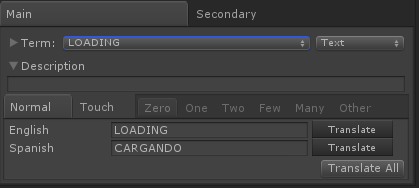Auto Translation
I2 Localization allows typing or importing the term's translation to each language, but most of the times its useful to use an automatic translation while developing the interfaces until a human translator could provide corrected translations.
There its a Translate button next to each language. When that button its clicked it contact Google Translate Web and downloads the translation of the term into the corresponding language. The source of the translation will be the first translated language that its not empty or the Term's name in case there is no translation already set.
To make translation easier, there its also a "Translate All" button that performs the translation to each of the empty languages.

There is also another Translate button next to each language in the LanguageSource. When clicked it finds all terms that are not yet translated to that language and generate each translation.
Auto Translated Plurals
The automatic translation also uses the language's rules to generate correct plurals for any parameter in the text.
This way if a text is "You have {[POINTS}]} points." it generates the plural, singular and zero variants (e.g. "You have {[POINTS]} points", "You have {[POINTS]} point" "You have no points").
For some languages it generates those 3 variants, but other languages can have up to 6 plural forms.
WebService
In order to access Google Translate, the plugin uses a WebService that its installed in your Google Drive. That allows the plugin to communicate with the Translate API and execute batch translation where all terms in a language are translated with just one query.
To setup the WebService, please follow the steps listed in the How to Link with Google topic.
Please, notice, that even if you don't intent on using Google Spreadsheets, the plugin requires the WebService in order to get the translations.
Created with the Personal Edition of HelpNDoc: Produce online help for Qt applications